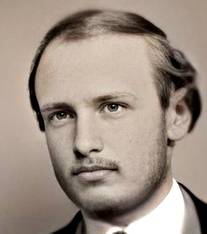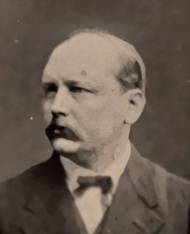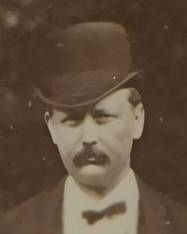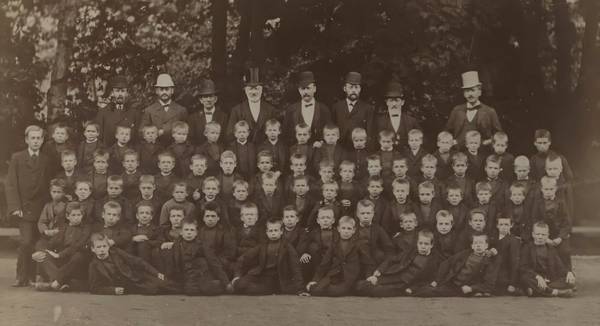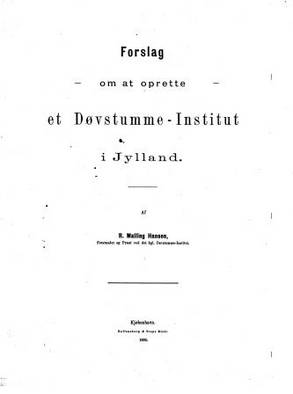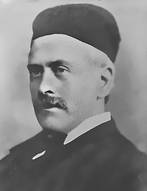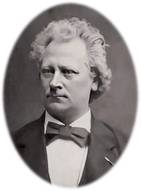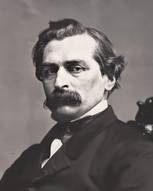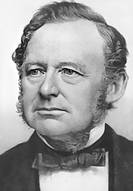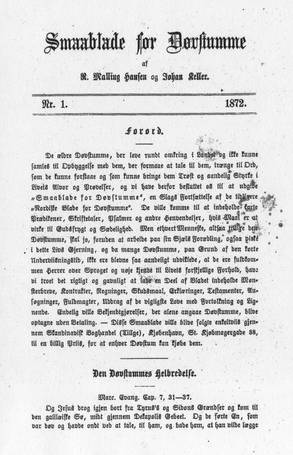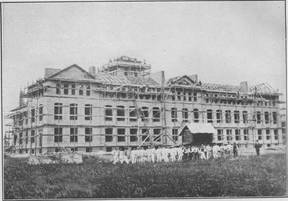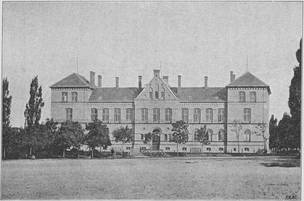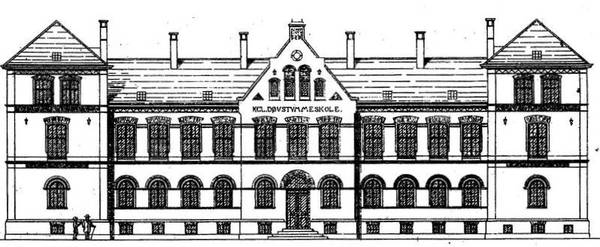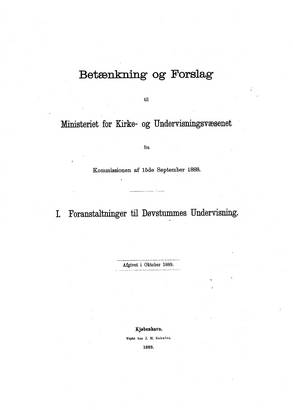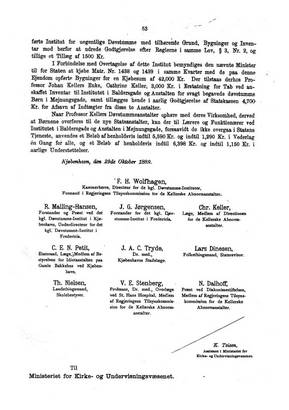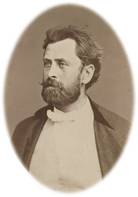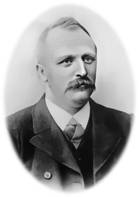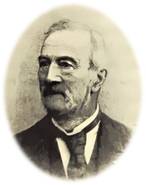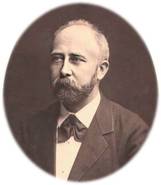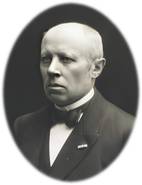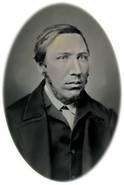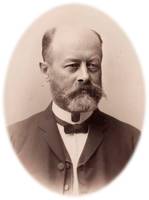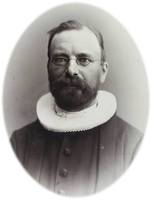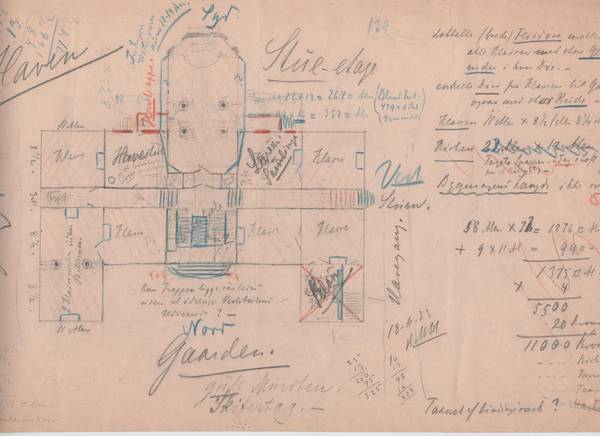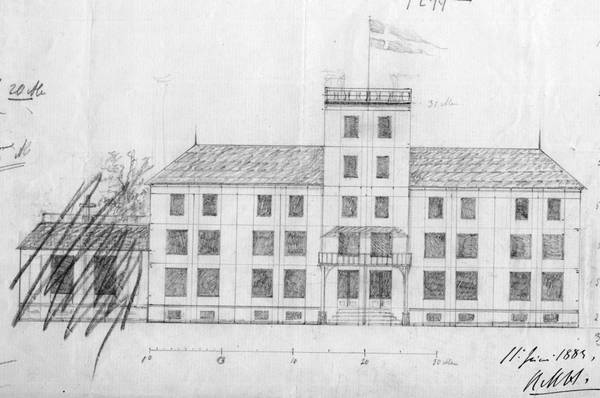Educational reformer
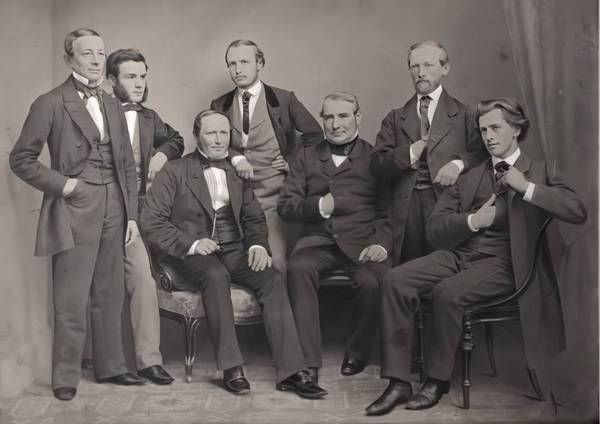
- The teachers at the Royal Institute for the deaf-mutes photographed in 1861. Rasmus Malling-Hansen can be seen in the middle behind. Sitting to the right of him is his future father in law, Søren Johan Heiberg, the principal at the institute. From the left: U. F. Gram, H. C. Lind, I. C. A. Gjøe, R. Malling-Hansen, S. J. Heiberg, A. C. Nyegaard og Georg Jørgensen. Photo: Døvehistorisk Selskab
In 1859 Rasmus Malling-Hansen applied for work as a teacher at The Royal Institute for the deaf-mutes in Copenhagen. He had a friend there, who had told him that the Institute was in need of a new teacher. Malling-Hansen not only got the job, he became a never resting force in the development of the organisation, the conditions and the pedagogical principles and methods for the teaching of the deaf-mutes in Denmark.
That Rasmus Malling-Hansen entered the teaching of the deaf-mutes seems to be one of these lycky strikes of faith, that sometimes occur, because his work and his observations of the pupils later also became the foundation of some unique discoveries and brilliant inventions!
Malling-Hansen's first period at The Royal Institute for the deaf-mutes lasted until 1861. He still hadn't finished his theological studies, so he now wanted to become a full time student. But not for very long - in 1862 his services were asked for - in Schleswig, which was a part of Denmark at that time, they needed a Danish teacher, and Malling-Hansen took on the task, and in 1864 he became the principal of the Institute there. But the war soon drove him back to Copenhagen, and after his exam in theology in 1865, he was hired as the principal at the Royal Institute in Copenhagen - a position he stayed in for 25 years. And these 25 years became a time of change and improvement of both the conditions under which the deaf-mutes lived, and also of the principles for the teaching and the organisation.
In 1868 Malling-Hansen went on a travel around Europe to study the teaching of deaf-mutes in the different countries. And he brought with him back to Copenhagen new impulses and new ideas, and he worked all the time to improve the conditions and the teaching at the Institute in Copenhagen.
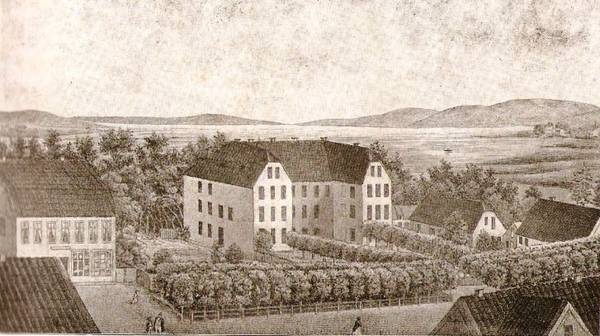
- Arno Blau wrote in his book, "150 years of Education for the Deaf-Mute in Schleswig-Holstein", p 29: “The Danish student Malling Hansen, for a short period working as a teacher of the Danish class, established in 1858, was on 23rd of April 1863 appointed as temporary principal and first teacher. He obtained formal royal appointment on January 27, 1864, however just 10 days later Hansen left his post and fled north together with the retreating Danish troops to Denmark. The campaign of 1864 had started. Two of the new teachers and the book-keeper of the institution followed Hansen’s example”. The picture above shows the institute in 1863, and was made by C. Struve.
Malling-Hansen was not satisfied with only letting the old traditions continue - he had an open mind, and an urge to do things in the best possible way, and to find good solutions to whatever was a problem. He was influenced by new thoughts, especially from Germany, that it was possible for many of the deaf-mutes to learn to read from the lips(the oral method), instead of only using sign language. The abilities of the pupils varied very much, and it was not easy to give them all a satisfactory education, when they were all assembled in the same school in the same classes. Some of them were what we today would call mentally retarded, while others only had reduced hearing, or had lost their hearing.
Malling-Hansen took the initiative to divide the pupils into three groups; The genuine deaf-mutes, the ones who totally lacked hearing and speaking ability - and the not genuine deaf-mutes, those who still could hear a little, or had not been deaf from their birth, and also had a little speaking ability, and finally the deaf children who also were mentally retarded. The second group could very well be taught by the oral method, and by a reform of 1867, it was decided to let the groups attend two different schooles, as The Royal Institute was decided to be responsible for the teaching of the genuine deaf-mutes, and The Keller Institutions were to be responsible for teaching the not genuine deaf-mutes, and also the mentally retarded.
This was a great improvement in the teaching of the deaf children, which led to a much better adjusted teaching for the children according to their abibilties, and Denmark had, thanks to Malling-Hansen, become the initiator of the Nordic countries.
Malling-Hansen must be said to have shown great foresight in this matter, and this was only the first step in the development that took place during his time as principal at The Royal Institute.
It's important to keep in mind that this was in the very early stage of the educational system. The conditions under which the pupils lived were difficult, and the understanding of the children's needs was limited. At the Institute the pupils had to work every day in addition to their education, and the hours were very long. They did not have much free time to play and relax. Malling-Hansen very early in his position as principal expanded the outside area of the Institute and made it possible for the children to take part in the gardening outside. He probably also wanted them to end the working in the school's workshops, but the school's financially situation prevented him from going throught with this.
The death rate at The Royal Institute in the early days was extreme. In the years from 1824 to 1839- 31% or 1/3 of all the children who attended the school died - most of them of lung diseases. Malling-Hansen's concern for the children's health led him to several improvements, and the most important was probably to take every free space in the building into use as class-rooms, in order to increase the volume of air per child. The school was overcrowded, and Malling-Hansen felt strongly that something had to be done to solve the space problem. He also reduced the hours of teaching, let the children sleep until 6 instead of 5, as earlier, and increased their free time. These efforts led to great improvements in the death rate. In the late periods of Malling-Hansen's time as principal, a lower percent of the children at the Institute died, than in the population of hearing children.
We know that Malling-Hansen had plans for installing electricity at the Institute, and also to set up a new building because of the increasing number of pupils, but unfortunately these plans were not approved by the authorities.
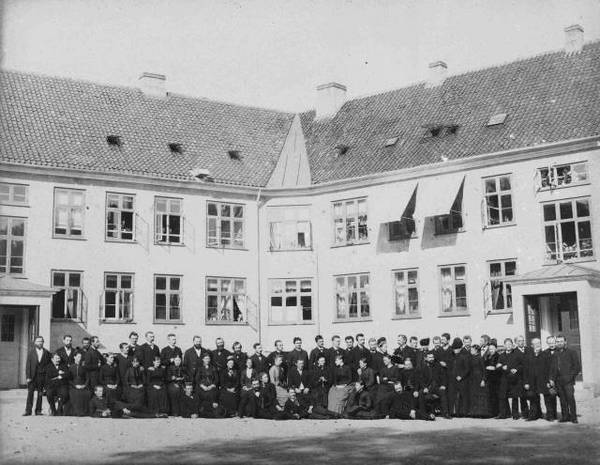
- This is a picture of The Royal Institute for the deaf-mutes from 1886. The occation is not known, but it is possible it's the 20. anniversary of the first danish Union for the deaf, founded in 1866. Malling-Hansen was a participant of the board of the Union for some years. Photo: The Royal Library in Copenhagen
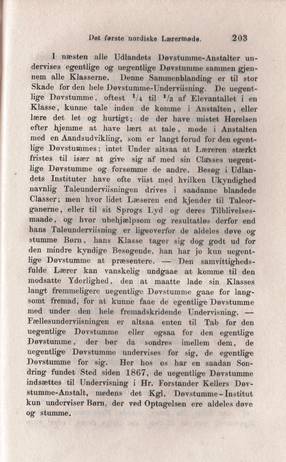
- This is a report from a lecture that Malling-Hansen helt at The Royal Institute for the deaf-mutes for the participants at the first school-meeting in Copenhagen in 1872. At the 28.th of June the Instutute was the host for the meeting, and the attendants could also witness Malling-Hansen as he examined his class using the oral method. The report was printed in the journal "Nordisk Tidsskrift for Blinde-, Døvstumme- og Aandsvageskolen, edited by J. Moldenhawer and Johan Keller. The topic of the lecture was the deviding of the deaf-mute into the genuine and the not genuine deaf-mutes
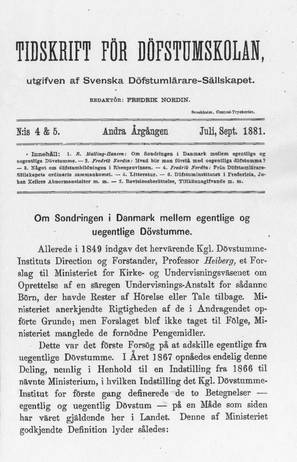
- In 1881 Malling-Hansen published an article in another Nordic journal, "Tidskrift för Döfstumskolan" and again he wrote about the genuine and not genuine deaf-mutes. The "Danish model" from 1867 - the deviding of the deaf-mutes into different groups depending on their hearing ability and cognitiv abilities was of great interest also to other countries. The journal was edited by Fredrik Nordin from Sweden
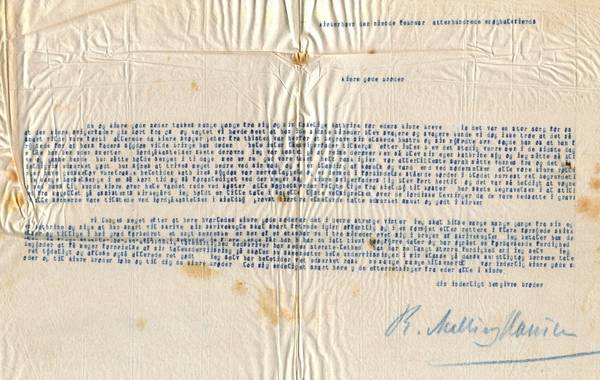
- Even thought the teaching at The Royal Institute in Copenhagen was based on the sign method, they also gave the children lessons in oral training, in 1868 6 hours pr. week. Malling-Hansen also used the oral method almost exclusively in his teaching of one of his classes, as he gave proof of at the large meeting in Copenhagen in 1872. In a letter to his brother from the 2.nd of September 1871 he writes about this class: "i am starting to get much pleasure from my oral teaching at the school now almost all the teaching in my class is performed in spoken Danish language and the children can speak quite clearly and can also already read on the lips quite well." (At this point the writing ball wrote only with small letters and was not equipped with a key with punctuation mark)
In 1879 Rasmus Malling-Hansen made a proposal to establish a new institute in Jylland. His plans were printed in 1880, and show a very detailed proposal, which included every aspect of the practical and pedagogical matters concerning a new school.
Malling-Hansen now also wanted some of the genuine deaf children to get their education by the use of the oral method, and his idea was to let the new institute teach only by this method. He strongly recomended that such an institute should not be situated in the capitol, because many of the older deaf-mutes who lived there could only use sign language, and would influence the young ones to start using signs instead of speech. Therefore it was important, according to Malling-Hansen, to build the new institute close to a provincial city.
His proposal was fully accepted by the authorities, and with the foundation of the Fredericia Institute in 1881, Malling-Hansen had now reached another one of his goals: To give the deaf-mutes their education according to the method that was best suited for their abilities.
-The Institute in Fredericia used the oral method for the genuine deaf children who could best benefit from that method.
-The Institute in Copenhagen used the sign method for the genuine deaf children who could best benefit from that method.
-The Keller Institutions used the oral method for the not originally deaf children, and the sign method for the mentally retarded.
As principal of the new institute i Fredericia, one of the teachers from the Institute in Copenhagen was employed, on the initiative of Malling-Hansen. His name was Georg Jørgensen and he was known as a dedicated follower of the oral method. He was convinced of this method's superiority during a study travel to the institutions in Europe in the mid seventies. He did not get much support from his Danish colleeges, apart from Malling-Hansen, but Malling-Hansen was of a much more pragmatic nature. He saw clearly that some of the deaf children would benefit from this new method, but he also saw that the older methods would be best suited for other groups of deaf children. But the clearsighted Malling-Hansen had in Georg Jørgensen found the man who was to become a dedicated principal of the Fredericia Institute.
Malling-Hansen himself was fully capable of teaching both according to the oral method and the sign method. His son-in-law, Fritz August Bech, who was a teacher at the Institute in Copenhagen, and who later became the principal at the Fredericia School, described Malling-Hansen's sign language to be extraordinary elegant and easy to understand. And already in 1872, at the large abnormal-school meeting in Copenhagen, the attendants to the meeting could watch how Malling-Hansen examined his class at the Institute, that he had trained unly by the use of the oral method.
During Malling-Hansen's time as principal of the Royal Institute for the deaf-mutes in Copenhagen, his great consern for the children's health and his ideas of giving the children an education best suitet to their abilities, led to great improvements both in the health conditions of the children and in the organisation and the methods of the teaching. Malling-Hansen was a man who never rested before he had found solutions to the challenges he was confronted with, and thanks to his efforts, the quality of education and the daily life of the deaf children in Denmark became radically better!!
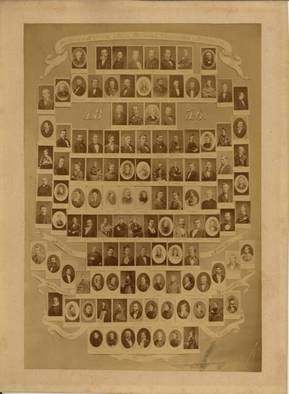
- On a large inter-nordic conference of the "abnormal"-schools, Rasmus Malling-Hansen was elected as chairman of the meetings. On this memory poster from the meeting, Malling-Hansen can be seen in the second row from the top - as number one from the left. See also the enlargement above. Photo: Døvehistorisk Selskab
But there still was the problem about the deviding of the pupils between the schools. It was often a matter of judgement, to decide wich school a student would rightly belong to. The Keller Institutions received financial support from the authorities according to the number of students that attended their school, and Malling-Hansen was of the opinion, that this fact lead The Keller Institutions to inscribe pupils, who in Malling-Hansen's opinion should have attended The Royal Institute. This lead to a state of competition between the two schools, and was the subject of a lot of struggle between Malling-Hansen and Keller. Allthough Malling-Hansen was a goodhearted man, he had an intense temper and could be extremely obstinate. Letters steaming of anger would often make their way between the two rivals, and the discussions in the newspapars could also often take the character of public laundry. As for Johan Keller the establishment of the Fredericia institute caused him to worry if the number of deaf-mute children in Denmark was large enough to give his institute sufficient enough pupils and thus enough money to maintain their capacity. In 1881 he therefore suggested to the ministry of education that The Keller Institutions were to receive a fixed amount of financial means instead of the support according to the number of students.
In 1884, the old director at The Royal Institute. J. P. Trap, had to resign because of illness, and Malling-Hansen was terrified that Johan Keller would be his successor. He probably wanted to have the position himself, but in his frear that Keller could possibly become his superior, he launched his own candidate, the former secretary of the Schleswig affairs, Wolfhagen. Maybe he knew him from his time as principal in Schleswig?
The frear turned out to be groundless - Johan Keller died before the position was filled, and Malling-Hansen could now launch his own candidacy - but too late. The ministery of education choose to employ Wolfhagen.
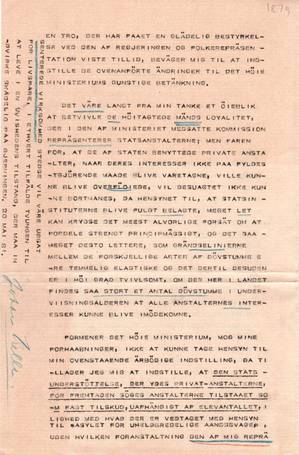
- The last page of the letter that Johan Keller wrote to the Ministry of Education in 1881 about the financial support to the Keller Institutions. It's difficult to know if this is Keller's original letter, or a copy written by Malling-hansen on his writing ball. If Johan Keller had a writing ball is unknown. Copyright: Døvehistorisk forening
During the time that J. P. Trap was director of The Royal Institute, he and Malling-Hansen had developed a way of working together, that worked very flexibly. In short the arrangement was that Malling-Hansen opened all the mail to the institute, both the mail to the director and to the principle. Only if necessary he consulted the director about important issues, in smaller matters he more or less decided on his own, and then informed the director about his decisions afterwards.
Obviously this arrangement suited Malling-Hansen very well, as he could run the institute's matters in his own way, without the interference of a superior. Trap suggested to Wolfhagen that he prolonged the arrangement, but Wolfhagen was a man of a totally different character than Trap, and it very soon became clear that his intentions was to exercise his position in a totally different way. He demanded to get total insight in the running of the institute, he opened his own mail, and took care of all the cases he was entitled to in his position as director. Malling-Hansen soon thought the new director went too far in his eager to have control, and even interfered with the matters that should naturally sort under the principal. The relationship between the two very soon became very difficult, Malling-Hansen intensely disliked this new situation, and it obviously must have disturbed his peace of mind in a serious way, because very soon he wrote an indignant letter to his superiors, setting farward accusations that the new director far exeeded his authority. Malling-Hansen did not get approval in case, but Wolfhagen was reproached that he had not shown more flexibility in his handling of the matters. The authorities obviously thought that Wolfhagen had been unnecessary provocative, and that much of the problems could have been avoided if his attitude toward Malling-Hansen had been more oblige.
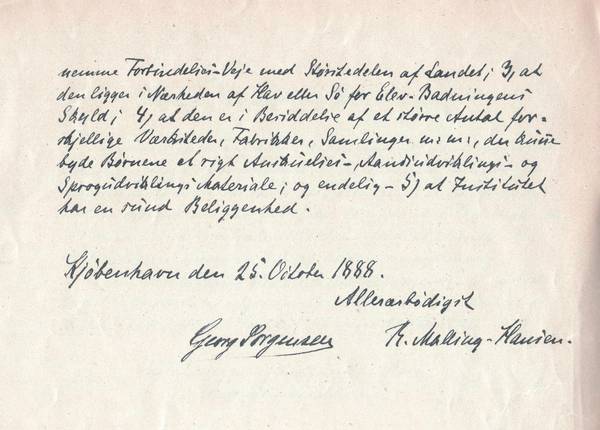
- A preliminary report from the Commission of 1888 written by Malling-Hansen and signed by himself and his old friend, Georg Jørgensen. They ended their work in 1889, and in 1890 most of their suggestions were approved in the Parliament. Malling-Hansen had reached his goal; The teaching of the deaf-mutes in Denmark was now coordinated and organized according to a common plan and lead by the authorities. The state of competion between the different institutes was now to become history.
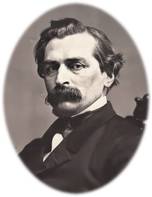
- Friedrich Hermann Wolfhagen, 1818-1894. Kammerherre, Directeur for de kgl. Døvstumme-Instituter, Formand i Regjeringens Tilsynskommission for de Kellerske Abnormeanstalter. Foto: DKB.
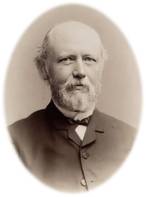
- Rasmus Malling-Hansen, 1835-1890. Forstander og Præst ved det kgl. Døvstumme-Institut i Kjøbenhavn, Underdirecteur for de kgl. Døvstumme-Institut i Fredericia. Foto fra 1890, privat.
Then in 1888 it was time for the last chapter in the history of the development of the Danish model for the teaching of the deaf-mutes during Malling-Hansen's lifetime. A Public commission was established, and once again Malling-Hansen was to work together with is old friend, the man who he had proposed as the principle of The Royal Institute for the deaf-mutes in Fredericia, Georg Jørgensen. Malling-Hansen had also had some large differences with him during the years over the teaching methods, and as so many times before, the differenses ended up as an intense quarrel in the newspaper when someone claimed that Georg Jørgensen was to thank for the establishment of the institute in Fredericia. This was not right, and the intense temper of Malling-Hansen once again led him to reply sharply to the false statements in the newspapers.
But the work of the commission was finished and the proposal that Malling-Hansen wrote was finalized in Parliament in 1890, and the result was that Malling-Hansen’s visions about a coordination of all the institutions for teaching of the deaf-mute under one joint overriding plan became reality. The state took over the responsibility for the Keller Institutions and at the same time a new institute was established in Nyborg. All deaf-mute pupils would henceforth be summoned to Fredericia in order to attend a preparatory pre-school, after which they would be channeled to various schools in accordance with their hearing ability and cognitive capacity, the purpose being to adapt the teaching as well as possible.
And only a few months later Malling-Hansen passed away. He had been the leading force in the reformation of the teaching of the deaf-mutes in Denmark through a periode of more that 25 years. The ideas that had first taken shape in his mind had now become reality, to the benefit of all the deaf-mute children in Denmark. During his lifetime the conditions for the children in the institute also had improved radically - the nutrition, the clothing, the working hours, the access to fresh air - Malling-Hansen's engagement for the welfare of the children had led to the result that the death rate of the children living in the institute in Copenhagen had sunk drasticly - and now was even lower than that of children living with their parents. No wonder Malling-Hansen was looked upon as a loving father figure by the children who he had in his care!
Oslo 26.09.06
Sverre Avnskog

